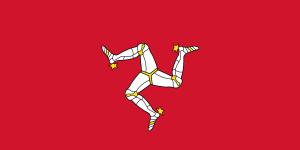Isle of Man

Exploring the Ancient Monuments of the Isle of Man
Standing with Stones is a remarkable and unprecedented documentary film that takes the viewer beyond Stonehenge on an incredible journey of discovery that reveals the true wealth and extent of Neolithic and Bronze Age Britain & Ireland. If you ever wondered what it would be like to travel the length and breadth of the British Isles, visiting the most intriguing and enigmatic monuments that our ancestors left us, from Cornwall through England, Wales, Ireland and Scotland to the outer reaches of the Hebrides and Orkney, then you will love this film. Described by one magazine reviewer as “A stunning study of standing stones. A work of art.” (Forten Times), this is no amateur travelogue. Written and presented by writer and explorer Rupert Soskin and shot and edited by broadcast producer Michael Bott, this film is a stunningly beautiful and absorbing two and a quarter hour tour of our ancient heritage in the company of an engaging and knowledgable host – the journey of a lifetime.
The Isle of Man (/ˈmæn/; Manx: Ellan Vannin, pronounced [ˈɛlʲən ˈvanɪn]), otherwise known simply as Mann (Manx: Mannin, IPA: [ˈmanɪn]), is a self-governing British Crown Dependency, located in the Irish Sea between the islands of Great Britain and Ireland. The head of state is Queen Elizabeth II, who holds the title of Lord of Mann. The Lord of Mann is represented by a Lieutenant Governor, but its foreign relations and defence are the responsibility of the British Government.
The island has been inhabited since before 6500 BC. As one of the six Celtic nations, Gaelic cultural influence began in the 5th century AD, and the Manx language, a branch of the Gaelic languages, gradually emerged. In 627, Edwin of Northumbria conquered the Isle of Man along with most of Mercia. In the 9th century, the Norse began to settle there. Norse people from Scotland then established the Kingdom of the Isles. The King’s title would then carry the suffix, “and the Isles.” Magnus III, the King of Norway, was also known as “King of Mann and the Isles” as part of the Hebrides civilization between 1099 and 1103. A Norse-Gaelic culture arose and the island came under Norse control. In 1266, the island became part of Scotland, as formalised by the Treaty of Perth. After a period of alternating rule by the kings of Scotland and England, the island came under the feudal lordship of the English Crown in 1399. The lordship revested into the British Crown in 1765, but the island never became part of the kingdom of Great Britain or its successor the United Kingdom, retaining its status as an internally self-governing Crown dependency.
Etymology
The Isle of Man is Manx: Ellan Vannin, where ellan is a Manx word meaning island. The earliest form of Man is Manu or Mana, which appears in the genitive case asVaninn, hence Ellan Vannin “Island of Man.”
The name Mana/u is related to the figure of Celtic mythology known as Manannán mac Lir to the Irish and Manawydan to the Welsh.
The name enters recorded history as Mona (Julius Caesar, 54 BC), and is also recorded as Monapia or Monabia (Pliny the Elder, AD 77), Monœda (Ptolemy, AD 150), Mevania or Mænavia (Orosius, 416), and Eubonia or Eumonia by Irish writers. Welsh records it as Manaw, and in the Sagas of Icelanders it isMön.
Though the Isle of Man was never incorporated into the Roman Empire, the island was noted in the Classics where it was called variously Monapia, Mοναοιδα (Monaoida), Mοναρινα (Monarina), Menavi and Mevania. The Old Welsh and Old Irish names for the Isle of Man, Manau and Mano, also occur in Manaw Gododdin, the name for an ancient district in north Britain along the lower Firth of Forth. The name is probably connected with the Welsh name of the island of Anglesey, Ynys Môn and possibly with the Celtic root reflected in Welsh mynydd, Breton menez, and Scottish Gaelic monadh, all of which mean “mountain” and probably derive from the Proto-Indo-European root *men-, “to tower.” In this case, such a name may have referred to the island apparently rising out of the Irish Sea on the horizon.
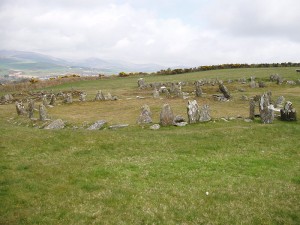 The Braaid in central Isle of Man, with remnants of a Celtic-Norse roundhouse and two longhouses, c. 650–950 AD
The Braaid in central Isle of Man, with remnants of a Celtic-Norse roundhouse and two longhouses, c. 650–950 AD
Rising water levels cut off the island from the surrounding islands around 8000 BC. Evidence suggests that colonisation of the island took place by sea some time before 6500 BC. The first residents lived in small huts, hunting, fishing and gathering their food. They used small tools made of flint or bone, examples of which have been found near the coast. Representatives of these artefacts are kept at the Manx Museum.
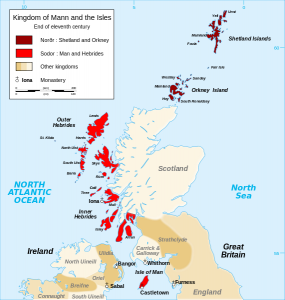 The Kingdom of the Isles about the year 1100. Sodor and Mann in red.
The Kingdom of the Isles about the year 1100. Sodor and Mann in red.
The Neolithic Period marked the coming of knowledge of farming, better stone tools and pottery. It was during this period that megalithic monuments began to appear around the island. Examples from this period can be found at Cashtal yn Ard near Maughold, King Orry‘s Grave at Laxey, Meayll Circle near Cregneash, and Ballaharra Stones at St John’s. This was not the only Neolithic culture: there were also the local Ronaldsway and Bann cultures.
During the Bronze Age, the large communal tombs of the megalith builders were replaced with smaller burial mounds. Bodies were put in stone-lined graves along with ornamental containers. The Bronze Age burial mounds created long-lasting markers around the countryside.
The Iron Age marked the beginning of Celtic cultural influence. Large hill forts appeared on hill summits, and smaller promontory forts along the coastal cliffs, while large timber-framed roundhouses were built. It is likely that the first Celts to inhabit the island were Britons speaking Common Brittonic. Around the 5th century AD, cultural influence from Ireland and migration precipitated a process of Gaelicisation evidenced by Ogham inscriptions, giving rise to the Manx language, which is a Goidelic language closely related to Irish and Scottish Gaelic.
Viking settlement of the Isle of Man began at the end of the 8th century. The Vikings established Tynwald and introduced many land divisions that still exist.
Geography
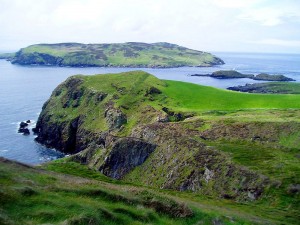 The Calf of Man seen from Cregneash – Geography of the Isle of Man
The Calf of Man seen from Cregneash – Geography of the Isle of Man
List of islands of the Isle of Man and Biota of the Isle of Man
The Isle of Man is located in the middle of the northern Irish Sea, almost equidistant from the islands of Great Britain and Ireland. The closest land is southern Scotland. It is 52 kilometres (32 mi) long and, at its widest point, 22 kilometres (14 mi) wide. It has an area of around 572 square kilometres (221 sq mi). Besides the island of Mann itself, the political unit of the Isle of Man includes some nearby small islands: the seasonally inhabited Calf of Man, Chicken Rock on which stands an unmanned lighthouse, St Patrick’s Isle and St Michael’s Isle. Both of the latter are connected to the mainland by permanent roads/causeways.
Hills in the north and south are separated by a central valley. The extreme north is exceptionally flat, consisting mainly of deposits from glacial advances from western Scotland during colder times. There are more recently deposited shingle beaches at the Point of Ayre. The island has one mountain higher than 600 metres (2,000 ft), Snaefell, with a height of 620 metres (2,034 ft). According to an old saying, from the summit one can see six kingdoms: those of the Mann, Scotland, England, Ireland, Wales, and Heaven. Some versions add a seventh kingdom, that of the Sea, or Neptune.
Population
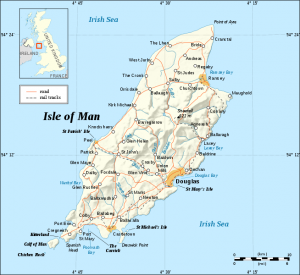 Map of the Isle of Man – Further information: Manx people
Map of the Isle of Man – Further information: Manx people
At the 2006 interim census, The Isle of Man was home to 80,058 people, of whom 26,218 resided in the island’s capital, Douglas. Most of the population was born in Britain or Ireland, with 47.6% born in the Isle of Man, 37.2% born in England, 3.4% in Scotland, 2.1% in Northern Ireland, 2.1% in the Republic of Ireland, 1.2% in Wales and 0.3% born in the Channel Islands. The remaining 6.1% were born elsewhere in the world.
Census
The Isle of Man Full Census, last held in 2011, has been a decennial occurrence since 1821, with interim censuses being introduced from 1966. It is separate from, but similar to, the Census in the United Kingdom.
The 2001 Census was conducted by the Economic Affairs Division of the Isle of Man Treasury, under the authority of the Census Act 1929.

